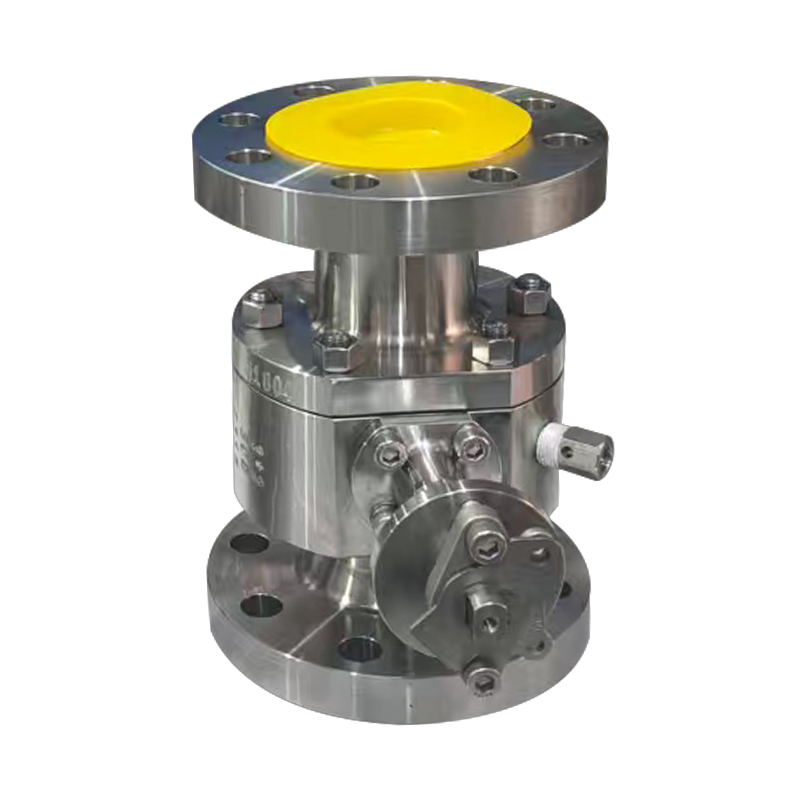
A floating ball valve is a valve in which the ball can float. Under the action of medium pressure, the ball can produce a certain displacement and press tightly on the sealing surface of the outlet end to ensure the sealing of the outlet end. The following is a detailed introduction to the floating ball valve:

Structural features:
The ball of the floating ball valve is fixed to the valve body through the upper valve stem, and the ball can float within a certain range.
The ball of the ball valve is not fixed but can produce displacement under the action of the medium pressure and press tightly on the sealing surface of the outlet end.
Working principle:
When the valve is opened, the ball is pushed to the outlet valve seat under the action of the medium pressure to achieve opening; when closed, the ball leans against the inlet valve seat and has a certain floating displacement.
Turning the valve stem and driving the ball core to rotate 90° can achieve the switching action of the ball valve.
Sealing performance:
The sealing of the floating ball valve mainly depends on the medium pressure to push the ball to the outlet valve seat, so that the ball fits tightly with the valve seat, thereby achieving sealing.
This design makes the ball valve have a better sealing effect during operation, but the ball is subjected to greater stress.
Applicable scenarios:
Floating ball valves are suitable for medium and low pressure small-diameter pipeline systems, are easy to operate, and are relatively economical.
It is also commonly used in general industrial pipeline systems, suitable for medium and low pressure conditions, and easy to operate and maintain.
Floating ball valves are suitable for a wide range of media, including water, gas, oil, natural gas, and acid-base corrosive media, etc.
Other features:
The floating ball valve has a simple structure and is easy to maintain. The sealing surface and the spherical surface are often in a closed state and are not easily eroded by the medium.
The flow resistance of the ball valve is small. When the full-diameter ball valve is opened, the ball channel, valve body channel and connecting pipe diameter are equal and form a diameter, and the medium can flow through almost without loss.
In summary, floating ball valves have been widely used in various industrial pipeline systems with their unique structural characteristics, working principles and excellent sealing performance.
The Process of Cast Iron Butterfly Valve Manufacturing
Cast iron butterfly valves are essential components in fluid control systems, commonly used in water distribution, wastewater treatment, HVAC systems, and various industrial applications. These valves regulate or isolate flow through a disc that rotates within the flow path. The manufacturing process is a systematic approach involving casting, machining, assembling, and testing, ensuring durability and efficiency.
The process begins with the selection of high-grade cast iron. This material is chosen for its mechanical strength, corrosion resistance, and cost-effectiveness. The iron is melted in a furnace and poured into a mold shaped like the valve body. Once cooled and solidified, the casting is removed from the mold and cleaned to eliminate any surface impurities or residues.
Next, precision machining is carried out on the cast body. This includes boring the seat area, drilling bolt holes, and shaping the shaft and disc interfaces to ensure accurate alignment. The butterfly disc—often made of the same cast iron or a corrosion-resistant alloy—is also machined to fit tightly within the valve seat, leakage when closed.
A rubber or elastomer seat is typically inserted into the valve body to provide a sealing surface for the disc. This lining is crucial for preventing fluid leaks and enhancing valve lifespan. The disc is then mounted onto a shaft, which connects to the actuator or handle used for valve operation.
Once assembled, the valve undergoes pressure and functionality tests. These tests verify that the valve can withstand operating conditions without leaking or malfunctioning. Valves that pass are cleaned, painted, and packaged for shipment.
The manufacturing of cast iron butterfly valves emphasizes precision and quality control at each step to ensure reliable performance in diverse applications.
The Development of the Universal Ball Valve
The universal ball valve represents a versatile solution in modern fluid control systems. Its evolution is marked by advancements in design, materials, and manufacturing techniques, making it adaptable for various industries such as oil and gas, pharmaceuticals, food processing, and water treatment.
Historically, ball valves were designed for specific applications with limited material options and standardized sizes. As industrial demands grew, there was a clear need for valves that could serve multiple roles without frequent customization. This led to the development of the "universal" ball valve concept—a valve capable of functioning across a wide range of pressures, temperatures, and media.
The universal ball valve is characterized by its spherical closure unit (the "ball") that rotates within the valve body to open or close fluid flow. A key innovation in its development was the floating ball design, which uses system pressure to enhance sealing. This was followed by the trunnion-mounted ball, suitable for high-pressure applications, which helped reduce operating torque.
Material science played a major role in its evolution. Early versions used brass or stainless steel, but modern universal ball valves now feature advanced alloys and composites that provide greater resistance to corrosion, wear, and chemical attack. Additionally, the use of PTFE and other high-performance polymers for valve seats has significantly improved sealing capabilities.

